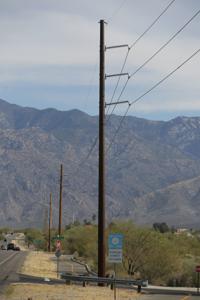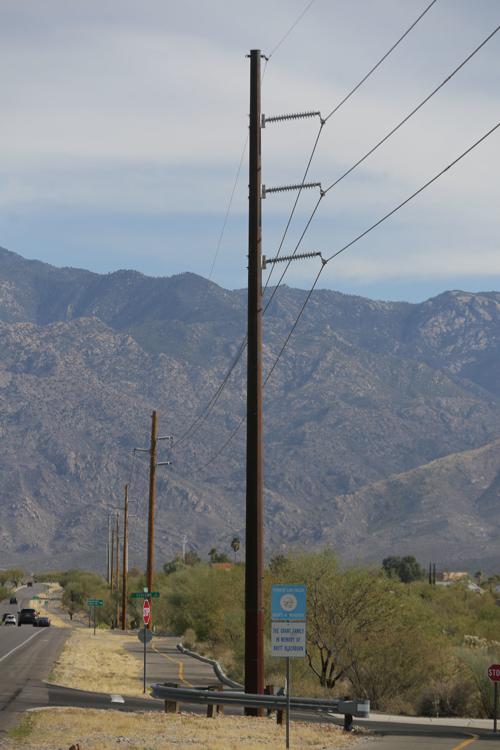A new high-voltage power line proposed by Tucson Electric Power Co. would cut through the center of Tucson, raising concerns from potential neighbors in the University of Arizona area and historic neighborhoods.
By 2023, TEP is planning to run a 138-kilovolt transmission line — suspended by 110-foot-tall poles — from a substation under construction at East 36th Street and South Kino Parkway to the DeMoss Petrie Generating Station, a gas-fired power plant just east of Interstate 10 north of West Grant Road.
TEP says the project, which also includes a new substation on the UA campus at the northwest corner of the Banner-University Medical Center campus, is needed to boost power capacity, improve reliability and tie into the UA and Banner-UMC campuses to meet growing demand.
TEP has not yet proposed a preferred route to state regulators who must approve it, and hearings on the route aren’t expected for at least a year.
But TEP this week released a map showing the project study area, with potential route segments that include lines along north-south alignments along Campbell Avenue, North Euclid Avenue and North Stone Avenue, and east-west routes along East Broadway, Grant Road and Speedway.
An official of the historic Sam Hughes Neighborhood — which could see the tall poles and lines go up along its border on North Campbell — said the proposed power lines and poles will kill views and are otherwise inappropriate for installation near residential neighborhoods.
“It just doesn’t belong adjacent to historic neighborhoods,” said Kathi McLaughlin, a Sam Hughes resident who sits on the neighborhood association’s TEP subcommittee.
“People wanting to enjoy a sunset from their patio are going to see these poles. It’s really sad that the people in this city haven’t screamed in outrage at this proposal,” she said, adding that there is concern that the poles will reduce property values.
A TEP spokesman said the new lines are needed to keep up with power demand in the area.
“The purpose of the project is to improve electric reliability for customers in central Tucson and to satisfy growing energy needs,” TEP spokesman Joe Barrios said, noting that some circuits in the study area are near capacity.
It’s not just the UA that needs more power, he said.
“The UA, certainly they have growing energy needs, but so do all of our customers,” Barrios said, noting that peak demand on TEP’s system is up 9% in the past five years.
“Adding capacity gives us more flexibility to serve all customers in the area.”
The route for the new transmission line must be approved by the Arizona Power Plant and Transmission Line Siting Committee, which will be asked to issue a certificate of environmental compatibility that will later be considered for final approval by the Arizona Corporation Commission.
TEP has yet to formally file its application for the new line but plans to do so in the third quarter of this year, Barrios said.
The company hopes to win final state approval in mid-2021 and start construction in early 2022, with a goal of putting the line into service by May 2023, Barrios said.
TEP is still in the early process of gathering required input from the public and other stakeholders as it narrows down preferred and alternative routes.
The utility held two public-comment meetings in October and has scheduled its next meetings for March 17 and 18.
Barrios said TEP is trying to be sensitive and responsive as possible to the concerns of local residents and other stakeholders, and urged people to submit comments.
“The goal is to continue to provide services to all those people in the area,” he said. “But we have to find a way to build the line to connect these substations, and it’s a challenge — it’s not easy to do in a densely populated area like this. The more feedback we get, the more it will guide our routing process.”
But Tucson City Council members and neighborhood leaders are leery of the project.
At a City Council study session Tuesday, council members expressed concern about potential brownouts, or voltage drops, in areas surrounding the power lines; questioned whether portions of the line could be buried underground; and discussed who decides the route that the power lines will ultimately follow.
Sam Hughes’ McLaughlin called the proposed poles “completely inappropriate,” “outrageously huge” and “completely out of scale.”
City and TEP officials said the city’s zoning examiner is limited to looking at the size and location of the UA substation and making sure that it’s enclosed by concrete.
The Corporation Commission ultimately makes the decision regarding the route, with the city limited to providing comments during the review process.
Councilman Steve Kozachik, whose university-area district includes historic neighborhoods concerned about the line, said his constituents are mainly concerned about the transmission line.
“The substation is what it is. It’s a utility with a chunk of concrete,” Kozachik said.
Residents of the surrounding neighborhoods have attended public hearings, distributed comment cards and tried reaching out directly to TEP officials. But McLaughlin said they have gotten nowhere.
“We speak for Sam Hughes, but we’ve been in contact with other neighborhoods that are potentially affected by this same issue,” she said, adding that they would be in favor of burying portions of the line.
Barrios said that while TEP buries some lower-voltage neighborhood distribution lines, the utility generally doesn’t bury high-voltage transmission lines because of high construction costs and the difficulty in gaining access for maintenance and repairs.
In response to neighbors’ concerns, Barrios said, TEP studied the potential cost difference and found that installing overhead lines would cost about $1 million per mile, while burying the line would cost about $11 million per mile.
Barrios said customers in some cases can pay for burying power lines, and neighborhoods may be able to set up special taxing districts to pay for such projects, but that’s not part of the Corporation Commission line-siting process.
TEP has also heard concerns from local residents concerned about the health effects of electromagnetic radiation emanating from the high-voltage lines, Barrios said. But utility officials say such concerns are unfounded, citing studies by the World Health Organization, national laboratories and the National Cancer Institute.
“There is a large and historical body of evidence about this issue and it confirms there are no confirmed health risks caused by EMF (electric and magnetic fields),” Barrios said, adding that the height of the proposed transmission poles allows the energy to dissipate before reaching ground level.
McLaughlin said she doesn’t trust the fact that the decision is being left up to the Corporation Commission, adding that the group is “going to get the cheapest route that makes the most money for (TEP’s) shareholders.”
“There’s no way to stop this train. It was put in motion long ago,” she said. “They’re going to get installed and we have no way of stopping it.”





